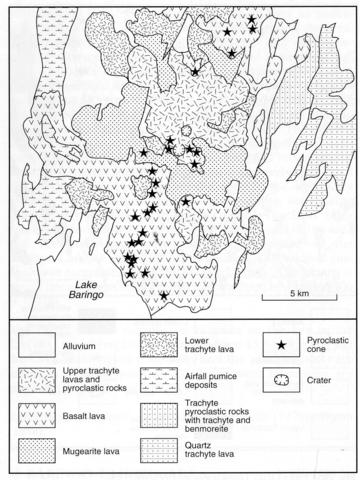stripes
Korosi is a basalt-trachyte volcano lying within the rift immediately north of Lake Baringo and Ol Kokwe and other islands in the lake (No. 085-00-035) can be considered as part of the Korosi volcanic complex. To the north it overlaps with the Paka volcano (No. 085-00-033). It rises 450-500 m above the rift floor and extends over 260 km2. Korosi is heavily fractured by a north-northeast-trending series of faults that developed throughout the evolution of the volcano and which are continuous with those affecting Paka. The stratigraphy according to Dunkley et al. (1993), on which the following account is mainly based, differs a little from that quoted by Hackman (1987b). The oldest exposed rocks are air-fall trachytic pumice and lapilli ash deposits that cover a large area to the west. They are overlain by Lower Trachyte lavas that erupted from vents on the upper flanks and summit area, some preserved as scoria and spatter cones, which built up an extensive shield. These vary from rare quartz-bearing trachytes to phonolitic trachytes with nepheline microphenocrysts; katophorite, arfvedsonite, aegirine-augite and sometimes fayalite. There was then effusion of fluid basalt and mugearite lavas the largest area of which covers about 100 km2 on the south and southwestern flanks with probably a significant area concealed beneath Lake Baringo. These lavas originated in a line of cones that extend from the shores of the lake to the summit area. Another extensive field of olivine basalt, hawaiite, mugearite and bemoreite lavas occupies low ground to the north and reaches the lower southern flanks of Paka volcano (No. 085-00-033). Upper Trachytes occupy a large part of the northern side of the volcano in the form of flows and extrusive domes, but there are also trachytic pumice and scoria deposits in this group. The Upper Trachytes are silica oversaturated pantelleritic and comenditic rocks, although Hackman (1988) refers to the presence of analcime in some of them, with alkali feldspar and rare olivine phenocrysts in a groundmass of these minerals together with aegirine-augite, katophorite and arfvedsonite. The youngest activity is considered to be represented by basalt lavas that erupted from a series of scoria and spatter cones in the low ground between Korosi and Paka. The general chemical classification of the rocks is indicated on a TAS diagram by Dunkley et al. (1993) who also give an average chondrite-normalised rare earth element plot for combined Korosi and Paka basalts, but do not quote the primary data. A detailed geological map, combining Korosi and Paka, on a scale of 1:50,000, accompanies Dunkley et al. (1993) who also describe the geothermal activity on the volcano.
DUNKLEY, P.N., SMITH, M., ALLEN, D.J. and DARLING, W.G. 1993. The geothermal activity and geology of the northern sector of the Kenya rift valley. British Geological Survey, Research Report. International Series SC/93/1: 1-185.HACKMAN, B.D. 1988. The geology of the Baringo-Laikipia area. Report, Geological Survey of Kenya, 104: 1-47.

